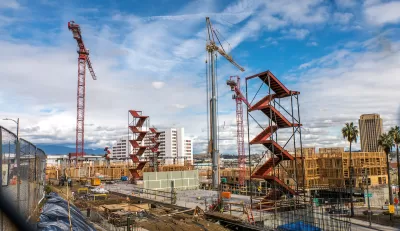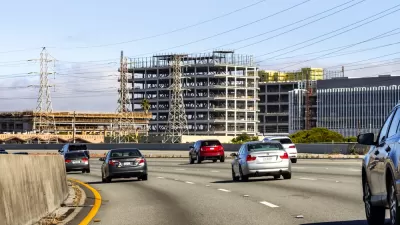The controversial law lets developers skirt local zoning rules in cities without state-approved housing plans.

California lawmakers want to curb the state’s ‘builder’s remedy’ law, an often overlooked state regulation that lets developers build projects that don’t conform to local zoning codes in cities without a state-approved housing element.
As Ben Christopher explains in CALmatters, “Despite its use as a hardball negotiating tactic by aggressive developers, no project has broken ground, much less finished, as a result of the builder’s remedy. That’s partially because relatively few developers are willing to make use of the confusingly-worded law for lack of legal certainty.”
State Assembly Bill 1893, authored by Assemblymember Buffy Wicks, would clarify and “modernize” the law, capping the size of projects and banning them in industrial zones. “The proposed overhaul, outlined in a newly amended draft of the bill published this morning, includes new perks for developers, textual edits to clear up how the law would apply and a provision to let developers who make use of other state laws allowing them to bypass environmental review and public hearing requirements to make use of builder’s remedy guarantees too.”
A second bill, AB 1886, would require an official sign-off from the California Housing and Community Development department.
The bills come in response to recent concerns over the vague — or in some cases nonexistent — limits of the law. Projects submitted under the builder’s remedy often get caught up in lawsuits, driving up costs and extending timelines. But “For ‘Yes In My Backyard’ activists who blame development-averse local governments for the state’s housing shortage, the builder’s remedy has been celebrated as the policy equivalent of the “F—- Around and Find Out” meme.”
FULL STORY: California’s most controversial housing law could get a makeover

Study: Maui’s Plan to Convert Vacation Rentals to Long-Term Housing Could Cause Nearly $1 Billion Economic Loss
The plan would reduce visitor accommodation by 25,% resulting in 1,900 jobs lost.

North Texas Transit Leaders Tout Benefits of TOD for Growing Region
At a summit focused on transit-oriented development, policymakers discussed how North Texas’ expanded light rail system can serve as a tool for economic growth.

Why Should We Subsidize Public Transportation?
Many public transit agencies face financial stress due to rising costs, declining fare revenue, and declining subsidies. Transit advocates must provide a strong business case for increasing public transit funding.

How to Make US Trains Faster
Changes to boarding platforms and a switch to electric trains could improve U.S. passenger rail service without the added cost of high-speed rail.

Columbia’s Revitalized ‘Loop’ Is a Hub for Local Entrepreneurs
A focus on small businesses is helping a commercial corridor in Columbia, Missouri thrive.

Invasive Insect Threatens Minnesota’s Ash Forests
The Emerald Ash Borer is a rapidly spreading invasive pest threatening Minnesota’s ash trees, and homeowners are encouraged to plant diverse replacement species, avoid moving ash firewood, and monitor for signs of infestation.
Urban Design for Planners 1: Software Tools
This six-course series explores essential urban design concepts using open source software and equips planners with the tools they need to participate fully in the urban design process.
Planning for Universal Design
Learn the tools for implementing Universal Design in planning regulations.
City of Santa Clarita
Ascent Environmental
Institute for Housing and Urban Development Studies (IHS)
City of Grandview
Harvard GSD Executive Education
Toledo-Lucas County Plan Commissions
Salt Lake City
NYU Wagner Graduate School of Public Service





























